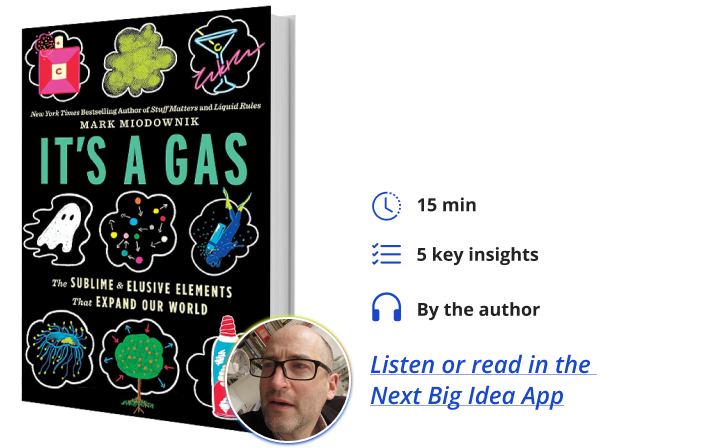Mark Miodownik, a materials engineer, is Professor of Materials and Society at University College London, where he established and directs the Institute of Making. He is the award-winning author of Stuff Matters. He regularly appears on BBC, leading various television programs, and is the creator and host of their radio show Glued Up: The Sticky Story of Humanity.
Below, Mark shares five key insights from his new book, It’s A Gas: The Sublime and Elusive Elements That Expand Our World. Listen to the audio version—read by Mark himself—in the Next Big Idea App.

1. The stuff we make matters because it is who we are.
We are people who make stuff—a lot of stuff—and that stuff is a mirror of ourselves. Embedded in what we make and why we make it is who we are. That’s why we named the ages of civilization after materials: Stone Age, Copper Age, Bronze Age.
We have those ages because every time we invent a new material, it changes everything. It changes how we live, interact with each other, and what we build. And that changes who we are as humans. Needs for materials are more than some sort of luxury. They are a kind of obsession that makes humans very special.
At first, these materials embodied our basic needs. We needed shelter, so we invented all sorts of building materials, starting with wood, moving on to stone, concrete for cities, and so on. As we got more impressive in our ability to transform the world into materials and structures, we started to embody our dreams and desires in them. This led us to build planes and spaceships as we honed our mastery of stuff.
The invention of gas can also embody our dreams. Gas technology embodies our dreams of travel. When we made boats, we harnessed the wind to construct incredible sailboats. Then, we invented balloons using a new gas in our toolkit: hydrogen. This very light gas allowed for exploration of the world from above. If you had a party in the 16th or 17th century, you had hydrogen balloons and hot air balloons—signals of the future.
Then steam came along, another gas technology. First, steam engines, then the steam railways. The railways changed everything about who gets to travel where. It democratized transportation. Before steam railways, most people grew up without ever seeing places beyond the horizon. They would never see the seaside or another country. Most people were agricultural and stood where they were because there was no good way to return. The steam engine helped everyone travel and go on holidays. In this way, everyone got to be these different people. Not just a few—everyone. The arrival of the bicycle did the same thing. The car, another gas technology, also did the same thing. It gave people independence, autonomy, and freedoms they had never dreamed of.
Mastering gas technology was, in a way, the hardest challenge for humans. We had to master the invisible because almost all gases can’t be seen, smelled, felt, or tasted. Yet, they’re incredibly powerful and have changed the way and who we are. If you think about it, we’re a migratory species now. Very few people are stationary. Almost everyone changes location daily. Some people fly every week. That’s all because of gas technology.
2. The act of making stuff is important.
You might be tempted to think the modern world was invented by these enormous, powerful corporations with trillion-dollar valuations and that they are the ones who give us amazing technology. But that’s not where the invention of the future happens.
The dreams we will fulfill in the next hundred years are developed by normal people in their workshops, inventing and tinkering. In the sweep of thousands of years of history, the big technologies that changed everything were often invented by two or three people who persisted in finding new ways to do things. The steam engine is a good example. Still today, it’s one of our most important gas technologies. Seventy percent of global electricity is made from steam engines. This future-building technology was invented by a preacher—someone with very good mechanical skills and an inventor by nature, wanting to solve a problem. The computer diode, which was the precursor to the computer chip, was invented by accident. It was a failed electric light bulb. It didn’t light, but it had another use.
“Seventy percent of global electricity is made from steam engines.”
People who can spot when an accident could be an insight into the future are living in our midst. They might be your neighbor. They might be you. Keeping the spark of invention alive in everyone is important for society. Experimenting and tinkering are in our DNA. You might think, well, I’m not someone with a workshop, but do you cook? Do you tinker in other ways? Maybe you garden? Hands-on activity is a very human thing.
Tinkering is radical and revolutionary, and you never know where it will lead. It changes many things in the world’s politics, too. Consider how carbon dioxide gas has gone from being this lovely, strange material discovered by Joseph Priestley and pumped into liquids to make fizzy drinks to now becoming our foe as an environmental issue. The person who invents a way to harvest CO2 from the air efficiently will be a trillionaire. Anyone could be the one to solve the latest problem, so long as we keep the spirit of invention alive.
3. Making stuff requires access.
Extending your capability to make things requires access to good tools. But we’ve been losing that access over time. Tools and the act of making have never been less a part of everyday life than for this generation. I grew up in an era when everyone mended their stuff. Having a sewing machine to fix clothes or tools for repairing a bike was normal. Modern homes, however, usually do not have a workshop or any space where a mess can be made or tools stored. There are even some houses being built without kitchens.
Loss of access to spaces for making is a potential problem for society. If we want to reach our hopes and dreams and solve current problems and needs, then we need a generation of people who grow up with access to space and tools for making, whether that’s at home, school, or work. I’ve been part of the invention of something called the Institute of Making, and I started it with my colleagues and friends Zoe, an artist, and Martin, a designer. We realized that people need multidisciplinary spaces in the modern world. A painter or cook, for instance, has just as much insight and right to be part of making the future as an electronics wizard.
People of various disciplines need to come together in a shared place to bring what is possible to the next generation. Look at history: James Watt made the steam engine more efficient, but it was his friend Matthew Boulton, an economist and social scientist, who understood how to make everyone realize that the steam engine was a game changer. He invented the idea of horsepower, which compared the power generated from a steam engine to how much power comes from a horse. Suddenly, people could easily understand how much more power a steam engine could provide, and truly value this invention.
4. The power of gases is often too alluring to resist.
Ancient peoples thought fire was a fundamental element of the universe, but it’s not. It’s a gas technology. Fire was one of the first technologies that really pushed our species ahead. The large size of human brains is attributed to people being able to cook food using fire because we gained more calories, food options, and time for other tasks.
Fire has stayed with us, being brought into our homes for heating and cooking. But fire has always been a threat to the buildings that contain it. When houses were made of wood or had straw rooftops, they sometimes burnt down. Sometimes, whole cities were destroyed by fire, whether by accident or through acts of war. There are always two sides to gases: benefits and dangers.
“The large size of human brains is attributed to people being able to cook food using fire because we gained more calories, food options, and time for other tasks.”
Gas street lighting demonstrates the dark and bright side of gas. In the early 1800s, most cities and towns were dangerous places at night. You could be mugged or murdered; moving around after sunset was dangerous. People wanted safer cities, so there was a push for street lighting. The only thing that could be done at the time was to harness methane and pipe it through the cities, but that was wildly dangerous and smelly. London gave it a try and chose to keep the gas lights. Despite issues of leakage and explosions, living in a palace of light was worth it. Even though electric lights illuminate cities now, gas brought us the beauty of lit-up cities.
We still have methane pumped through our cities, primarily for heating and cooking. The pipes still leak, and not a week goes by without an enormous explosion in some big city, reducing whole buildings to rubble. We can’t quite let go of methane.
The next flammable gas that will likely be a big part of our economy is hydrogen. We will have to grapple with a future driven by hydrogen. Hydrogen is particularly difficult to control because the atoms are so tiny that they can travel through solid materials. Leaks are almost impossible to stop.
5. The gases we depend on are our life support.
Life evolved on this planet when there were only trace amounts of oxygen in the atmosphere. The early Earth did not look like a blue planet; it looked orange. Thanks to a magnetic field protecting the beginnings of life from wind and sun, life took hold here and started to harness oxygen.
Oxygen is an incredibly powerful molecule. It allows for multicellular life. Astrophysicists see evidence of oxygen in a planet’s atmosphere because it’s so reactive. Oxygen quickly turns into rock, like silica rock or iron oxide rocks. Oxygen produced by life quickly reacts with its surroundings.
The importance of harnessing oxygen can’t be understated. Think about going to the hospital without it. Paramedics rely on using oxygen. You can die in a matter of minutes without it. Oxygen is a life elixir, allowing us to go to places like outer space. We need to be able to bottle it and produce it in space. We need this ability in submarines, too. To create habitable places where there is no oxygen, we need to create mini-Earths. Control of oxygen, among other gases like nitrogen, has been how we developed life support systems in hospitals, reached the moon, and explored the far reaches of this planet.
The planetary increase of carbon dioxide is a threat because of the heating it creates. We seek to control atmospheric levels of carbon dioxide to prevent this heating. That is a big challenge because it means controlling the whole atmosphere’s gas content. But it’s a matter of our life support system, so that’s what we’re trying to do. We are attempting to be godlike in our control of a whole planet and its atmosphere. I’m pretty sure we’ll get that control, but can we handle that power when we get it? There’s so much more left to happen in the story of gas.
To listen to the audio version read by author Mark Miodownik, download the Next Big Idea App today:
































